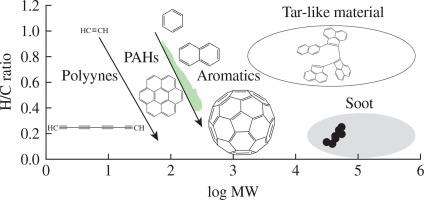烟尘核的双通道形成:实验和模型证据
IF 1.7
4区 化学
Q3 CHEMISTRY, MULTIDISCIPLINARY
引用次数: 0
摘要
在苯、乙烯、乙烯-甲烷和乙烯-丙烷与氩气稀释的热解过程中,对乙炔浓度和烟尘颗粒集合特征的冲击管测量结果与基于 Galerkin 方法的 MACRON 程序中实施的烟尘形成统一动力学模型的预测结果进行了比较。模拟结果表明,乙烯单独热解和使用指定添加剂热解的结果与实验数据十分吻合,从而证实了烟尘核形成的两种途径机制。苯热解的模拟结果与实验数据的吻合程度较低。本文章由计算机程序翻译,如有差异,请以英文原文为准。

Two-route formation of soot nuclei: experimental and modeling evidence
The results of shock-tube measurements of acetylene concentration and characteristics of the ensemble of soot particles during the pyrolysis of benzene, ethylene, ethylene–methane and ethylene–propane diluted with argon are compared with the predictions of the unified kinetic model of soot formation implemented in the MACRON program based on the Galerkin method. The simulation results demonstrate good agreement with experimental data for the pyrolysis of ethylene alone and with the specified additives, thereby confirming the two route mechanism of soot nuclei formation. The agreement for benzene pyrolysis is less satisfactory.
求助全文
通过发布文献求助,成功后即可免费获取论文全文。
去求助
来源期刊

Mendeleev Communications
化学-化学综合
CiteScore
3.00
自引率
21.10%
发文量
226
审稿时长
4-8 weeks
期刊介绍:
Mendeleev Communications is the journal of the Russian Academy of Sciences, launched jointly by the Academy of Sciences of the USSR and the Royal Society of Chemistry (United Kingdom) in 1991. Starting from 1st January 2007, Elsevier is the new publishing partner of Mendeleev Communications.
Mendeleev Communications publishes short communications in chemistry. The journal primarily features papers from the Russian Federation and the other states of the former USSR. However, it also includes papers by authors from other parts of the world. Mendeleev Communications is not a translated journal, but instead is published directly in English. The International Editorial Board is composed of eminent scientists who provide advice on refereeing policy.
 求助内容:
求助内容: 应助结果提醒方式:
应助结果提醒方式:


